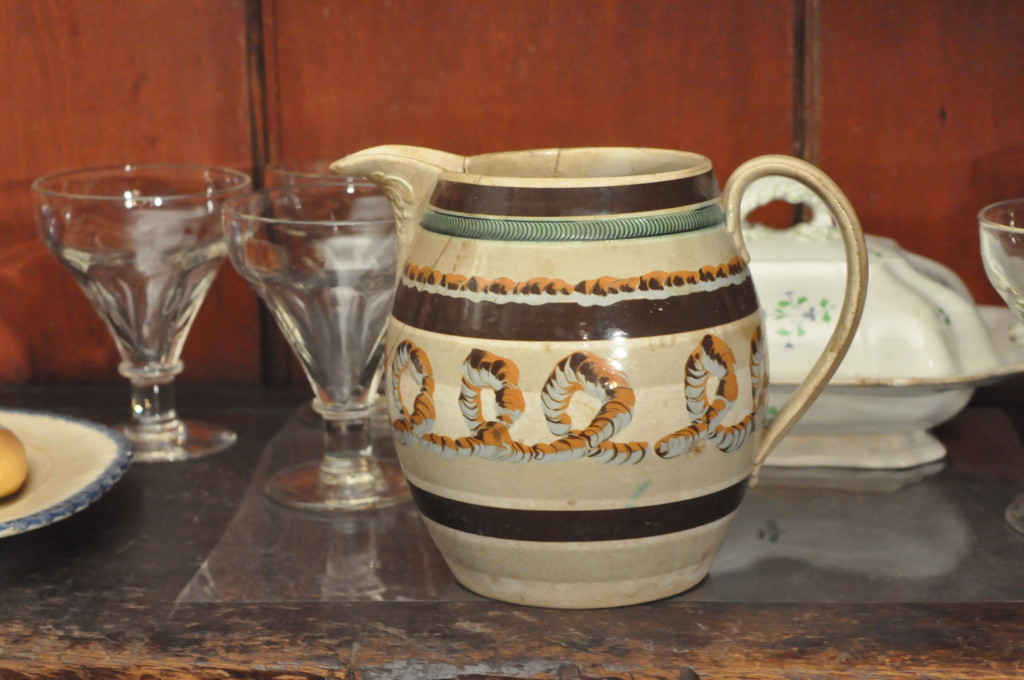
One of two related presentation pieces made by Baldwin Gardiner’s silver manufactory in Manhattan, circa 1827-30.
NEW YORK CITY — Visitors to New York City during Antiques Week whose interests run to American decorative arts will note an important exhibition of over 150 examples of china, silver and glass table wares made for the New York market between 1815–1835, on loan from private collections. “A Taste for the Fantastic: Setting the Table in 1820s New York” is on view at the Mount Vernon Hotel Museum & Garden through February 5.
This exhibition surveys a wide diversity of imported and domestic furnishings associated with dining during the early Nineteenth Century. The articles supplement the Mount Vernon Hotel Museum’s own permanent collections of decorative arts and fine furniture made in New York. It includes table settings in period rooms interpreted in the tastes of the 1820s and ‘30s when the Mount Vernon Hotel operated as a fashionable daytime inn catering to the carriage trade and daytime steamboat passengers who patronized Mount Vernon at the height of its popularity.
Guest curators Allen and Jean Miller of Historic Collections Foundation have collaborated with Mount Vernon’s curator Ruth Osborne and the Mount Vernon staff to present objects in various contexts thematically linked in time and by reason of having been imported to or made in New York City, marketed to local patrons and the country carriage trade by New York’s house furnishings stores or made by the city’s gifted craftsmen.
On the museum’s ground floor, drinking and earthenware are displayed in the tap room, gentlemen’s parlor and cooking kitchen in settings that transport the visitor to a moment in time when patrons of the hotel took refreshment after viewing the horse races across the street or strolled about the Mount Vernon agricultural fair before returning home aboard stage coaches or steamboats destined for Harlem or northbound up the Hudson.
Another highlight of the exhibition is a dining table set with the same china, glass and silver patterns selected by newlywed Anna Pell and her mother Anne Clarke for the young bride’s townhouse on Franklin Street in 1834. The tableau is based on a surviving bill from New York City merchant Baldwin Gardner’s Furnishing Ware House on Broadway, which lists over 60 items purchased for Anna’s trousseau. Upstairs, other tables are set with transferware china patterns and styles of Anglo-Irish and American cut glass which Anne Clarke herself chose over the two decades of her marriage to George Clarke for their Albany townhouse and for the Clarkes’ country house, Hyde Hall, upstate at the head of Lake Otsego.

George Clarke bought a 145-piece dinner service of “British Views” in May, 1824 from Webb & Dummer. The archaeology and bill itemization confirm that the pattern was “Grapevine Scenery” made by Enoch Wood’s pottery in Staffordshire. Each form has a different transfer printed scene
The Millers have reconstructed four table settings based on Clarke Family bills spanning 1813 to 1833 and on archaeological fragments of contemporary printed transferware found at Hyde Hall, now a house museum. They have collected over 175 examples of hand decorated creamware, transfer-printed earthenware and utilitarian stoneware based on studying 2,000 potsherds collected by state archaeologists and Hyde Hall’s staff over the last 50 years.
“Although this collection has been formed for its eventual permanent installation at Hyde Hall,” Miller explains, “a great portion relates directly to the material culture of New York City in the 1820s and ‘30s, which makes Mount Vernon Hotel Museum a perfect venue in which to display it presently.”
George Clarke, great grandson of the first Lieutenant Governor of the New York Province under English colonial governance, lived in New York between 1806 and 1810 and brought with him sets of English silver and earthenware when he immigrated to America from Cheshire, England. During his courtship with Anne Lowe Cary Cooper, and after their 1814 marriage in Albany, Clarke bought vast amounts of glassware and china from Webb and Dummer, the Albany retail partnership of New York housewares importer and merchant, George Dummer.
Examples of imported English glass as well as rare American forms attributed to Dummer’s Jersey City glassworks and other New York region glasshouse are presented side by side for comparison along with rare forms of cut glassware made in Pittsburgh and Boston during the same period.
The exhibit includes unique specimens from the Millers’ early Nineteenth Century American cut glass collection, which has “been in the formation for over 30 years and has come to underscore how little is known about New York and Jersey City cut glass production compared to well-studied examples from other glass-making centers of the period.” What started out as an “instinct to collect decoratively pleasing examples” Mr Miller says “turned into a passion for collecting information. Unlike hallmarked silver and china with makers’ marks, early glass is rarely, if ever, labeled.”
Another display contains presentation silver and silver tea serving pieces made by craftsmen in the workshops and ‘manufactories’ of New York’s leading silversmiths.
The exhibition is open during museum hours, 11 to 4. Special events and group tours for advanced collectors, decorative arts scholars and museum professionals during Antiques Week can be arranged in advance.
Mount Vernon Hotel Museum & Garden is at 421 East 61st Street. For information or guided tours, contact Mount Vernon staff at 212-838-6878 or r.osborne@mvhm.org.

Mocha and green banded jugs like this one were advertised by New York merchants Fish & Grinnell in 1820 and 1825.

This table is set with two virtually identical chinoiserie transfer patterns with gadroon edging from the J&W Ridgways and Ralph Stevenson & Sons potteries in Staffordshire, circa 1820-1830. The Clarkes bought a set from H&W Webb in 1827 to replace the Grapevine Scenery series which was lost when the first kitchen at Hyde Hall burned.

An interesting story lies behind this rare cut and engraved jug presented to Thomas W. Pearsall George Dummer’s factory.





